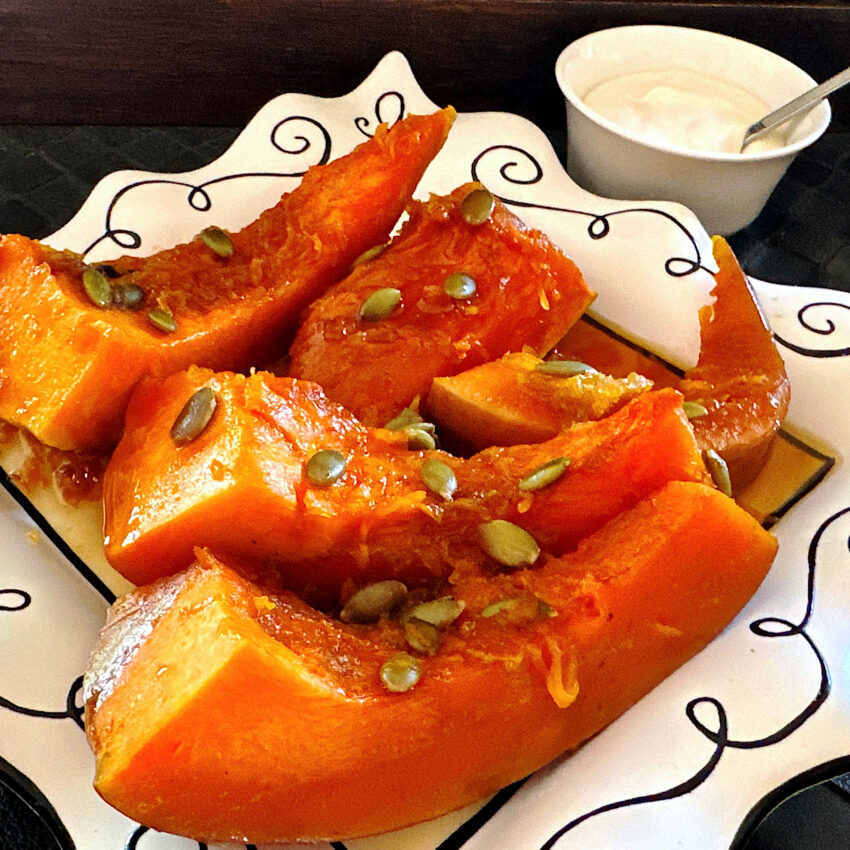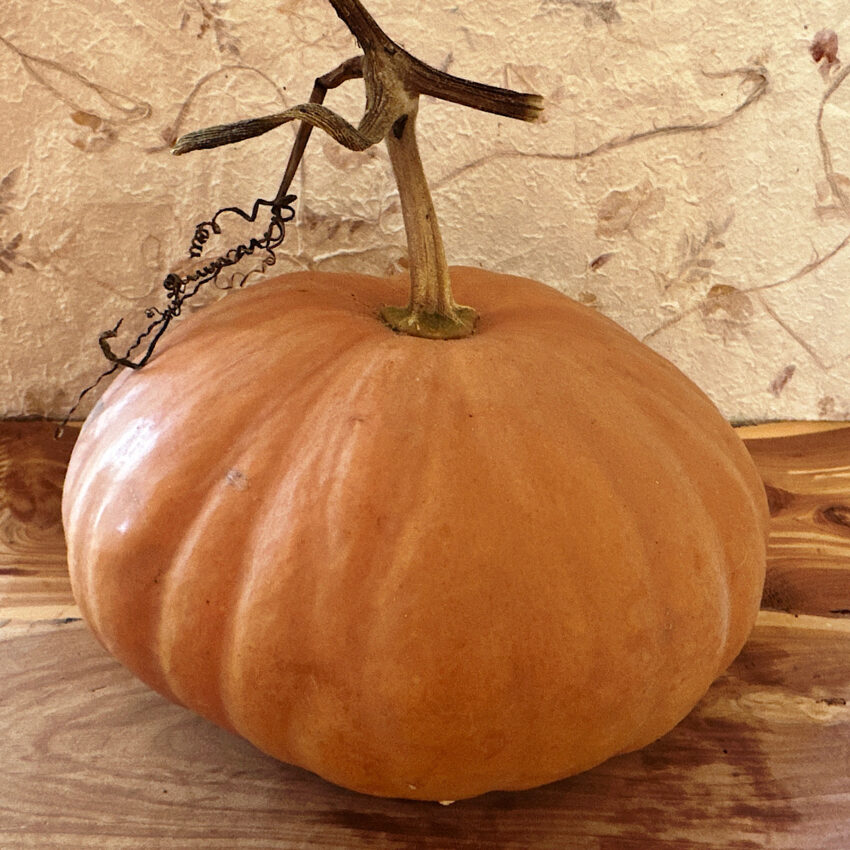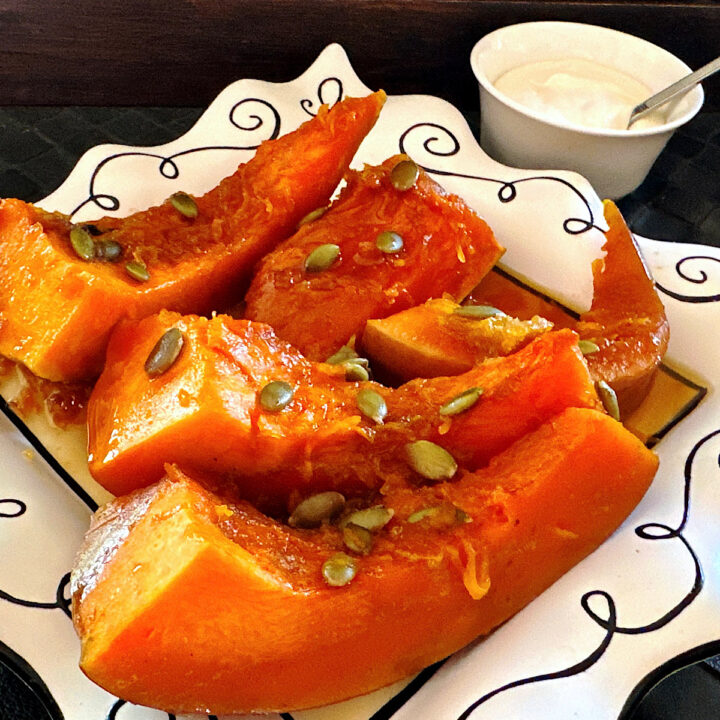Calabaza en Tacha (aka candied pumpkin) is one of the traditional treats served on Mexico’s Day of the Dead Celebration, “Dia de Muertos”. The flavor is similar to what is served in the US as candied yams or sweet potatoes, but the key ingredients to this Mexican recipe include piloncillo syrup, cinnamon sticks, orange peel and of course the pumpkin.

Jump to: RECIPE | What is Calabaza? | Best Pumpkins to Use | Tips for Enhancing Flavor | Substitutions | How to Serve
This post may contain affiliate links. As an Amazon Associate, I also earn from qualifying purchases. You can read our disclosure information here–
What is Calabaza en Tacha?
Calabaza en Tacha, or candied pumpkin, is a traditional Mexican celebration recipe. Sliced Winter squash is simmered in a syrup of piloncillo (or brown sugar) and aromatic spices.
It is one of those traditional treats prepared especially for Día De Los Muertos, a celebration on November 1st and 2nd that honors and celebrates the life of those who have died. It is one of the most common foods placed on family altars during this Mexican holiday.
If you prefer a similar dish using sweet potatoes rather than squash, this sweet potato casserole is really popular on the American holiday table.

Unlike the Thanksgiving sweet potato side dish however, Calabaza en Tacha is usually enjoyed in Mexico as a dessert, snack, or even as breakfast (often drizzled with crema).
Other Mexican food and drink recipes served at various Mexican celebrations might include one of these ten popular Mexican celebration dishes.

Best Pumpkins to Use for Candied Pumpkin
In Mexico, candied pumpkin is usually made with calabaza de Castilla, a light-colored Winter squash with a tough rind. Cooks used to drill holes in the tough rind to allow the sugar syrup to penetrate.
You can use any type of Winter squash to make this recipe, but if the rind is tough poke it a few times with a knife (no drill required).
The Calabaza is a West Indian type of winter squash, with a sweet flavor and very firm texture. It looks similar to an American pumpkin, but the flavor more closely resembles butternut or acorn squash. They are very popular in the Caribbean and Central and South America.
In the recipe below I used a variety of Winter squash called Long Island Cheese, as it has bright orange flesh and a smooth, dense texture.
Most Winter squash will work for this recipe. I would just avoid the kind of pumpkins sold for carving jack o’ lanterns. They are not the best in flavor.

I grow heirloom Winter squash and have provided a summary of flavor and texture of my favorite heirloom squash if you want more information.
Tips for the Best Flavor
While this is a fairly simple recipe, there are a few things you can do to eke out the best flavor possible:
- Cut your preferred squash into even pieces that are large, but not so big they won’t fit into your pot. The shape doesn’t matter. I cut mine into slices 1 1/2” thick and about 4-5” long to fit into a large dutch oven.
- Don’t worry if your pumpkin slices are not completely covered with the syrup. They will release some of their juice and that will help to cover them.
- Poke some holes in the rind with a sharp knife before placing them in the pot so they can uptake all of the sugar syrup.
- Place pumpkin slices in the pot, rind side down.
- Select your favorite aromatic spices. I used the traditional cinnamon sticks and cloves, but then added some star anise. Cardamom would be good also.

Ingredients & Substitutions
There are very few ingredients in this candied pumpkin recipe: the squash, the sugar and the spices (with optional crema drizzled on top).

Here are the typical substitutions you might find from cook to cook:
Squash/Pumpkin
- Butternut squash
- Cinderella pumpkin
- Long Island Cheese
- Basically any type of Winter squash that has good flavor and density (no carving pumpkins)
Piloncillo
Piloncillo is sometimes referred to as Mexican brown sugar. Although similar to American brown sugar, it is less processed.
Piloncillo is not as sweet as granulated white sugar and when reduced it turns into a syrup with notes of smoke, caramel and rum. Mmmm.
If you can’t find piloncillo, you can substitute it by weight with dark brown sugar and molasses (1 cup dark brown sugar + 2 teaspoons of molasses).

Spices & Flavoring
Orange and cinnamon and a bit of salt are the key flavors added to the syrup. Different cooks will also add cloves, star anise and/or allspice.
The oranges can be zested ahead of time or just sliced and added to the simmering syrup. Some cooks will add their favorite spices (mine is cardamom), but it is not necessarily traditional.
An added benefit to the flavor here is the sweet and spicy aroma that fills the house while it is simmering!
How to Serve
I’ve seen many different ways that people serve and enjoy this dish. A classic way is to have it with Mexican crema, either drizzled over the top or used as a bed in a bowl with the pumpkin sitting on top.

Sometimes the candied pumpkin is served without crema in a bowl of syrup with more syrup drizzled on top.
My favorite is to cook the pumpkin seeds along with the pumpkin in the syrup and then drizzle crema on top of the pumpkin and add a few roasted pumpkin seeds for crunch. Here are a few more variations:
- Pour a little liquid crema or evaporated milk over each portion.
- Sprinkle a few shelled, toasted, and salted pepitas (pumpkin seeds) over the pumpkin.
- Top dried cranberries.
Frequently Asked Questions
Homemade candied pumpkin can be stored in an airtight container in the fridge for up to 10 days thanks to the sugar that acts as a preservative.
The traditional ways to enjoy candied calabaza in Mexico is at breakfast with a glass of cold milk, as a late-afternoon snack, or as a dessert with crema drizzled over.
If you enjoy all types of Mexican food, check out this category of ALL Mexican recipes, where you will find over 40 Mexican recipes, from casual, to low carb, to fancy.
Like this recipe? It helps me out greatly if you leave a 5-star 🌟🌟🌟🌟🌟rating in the recipe card below and maybe even leave me a quick comment too!
Mexican Candied Pumpkin
Equipment
- sharp knife Or cleaver to cut through the squash
- measuring cups Or scale
Ingredients
- 4 cups water
- 8 ounces brown sugar
- 2 teaspoons molasses dark if possible
- 2 6” cinnamon sticks
- 1 orange sliced (with rind left on)
- 6 cloves
- 1 star anise
- ½ teaspoon kosher salt
- ¼ cup pepitas
- 3 pounds Winter squash with hard rind
- Mexican crema and fresh pepitas for serving additions
Instructions
- Make the syrup: add water, sugar, spices, pumpkin seeds and orange slices to a large pot or dutch oven. Bring the heat up to medium high to dissolve the sugar (stirring), and when sugar is dissolved turn heat down to maintain a simmer.Simmer for about 20 minutes or until liquid releases the aromas and becomes a little syrupy.4 cups water, 8 ounces brown sugar, 2 teaspoons molasses, 2 6” cinnamon sticks, 1 orange, 6 cloves, 1 star anise, 1/2 teaspoon kosher salt, 1/4 cup pepitas
- While the syrup is cooking, slice the pumpkin into wedges or a shape that will fit into the pot you are using. I sliced mine into slices about 1 1/2” thick and about 5” long for a large dutch oven.Once sliced, use a sharp knife to carefully poke some holes into the rinds so the syrup can penetrate to the squash flesh.3 pounds Winter squash
- Add the pumpkin slices to the pot of syrup, rind side down. It’s OK if they are not completely covered, as they will release some of their own juice.Simmer for about 30 minutes, or until the squash is soft enouth that a fork will easily penetrate the flesh.Remove from heat and let it sit for another 10 minutes. Serve with a side of Mexican crema and some fresh pepitas.Mexican crema and fresh pepitas



This one looks delicious!
It truly is. It’s a great dish to make for Winter holiday eating.
How long are you able to store it?
Well, it will keep in the fridge for quite a while, due to the sugar being a preservative (at least a week). I have to say howver, that the texture was much better when served the same day. It got a little sticky after storing a week. You could probably add some water to it before reheatin.